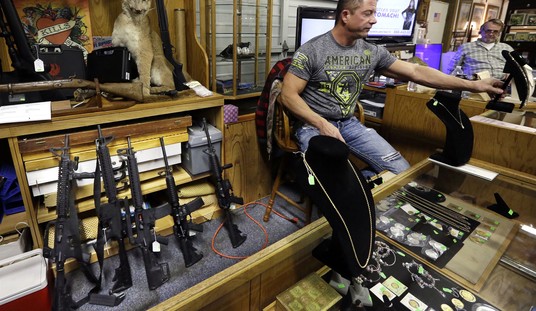The text of the Second Amendment is, all in all, surprisingly clear for a bit of law. The same can be said for most of the Bill of Rights, of course, but the Second is particularly important, and it’s the reality of that we need to talk about. After all, few disagree that people have the right to assemble, worship as they please, or petition the government. The idea that people should be protected from unreasonable search or seizure is also pretty well agreed upon.
But there is this weird perception of the Second Amendment that simply doesn’t conform to anything real.
You see, there are still those who think the individual right to keep and bear arms is a modern invention and call any claim to the contrary a fabrication.
Like this dipstick from The Hill:
The gun lobby’s triumphs have been due in large part to two coordinated and well-funded disinformation campaigns. The first was designed to revise legal scholarship around the Second Amendment and the second flooded Americans with false information about the benefits of firearms. These campaigns use what is called a “firehose of falsehood” strategy, a type of disinformation campaign that is challenging to counteract and has four foundational features:
- It is high-volume and multichannel
- It is rapid, continuous and repetitive
- It lacks a commitment to objective reality
- It lacks a commitment to consistency
The first firehose deployed by the gun lobby was intended to change the interpretation of the Second Amendment itself. The book, “The Second Amendment: A Biography,” found that before 1960, every law review article on the Second Amendment rejected the “individual rights” interpretation touted by the gun lobby, which was trying to claim that the Second Amendment should be applied to an individual, not just to a group (such as a militia).
And?
What? I’m supposed to be moved that law review articles–which are authoritative in many ways, but are not how we are governed, nor should they be–found something that makes absolutely no sense?
See, the author is trying to use law review articles and a review of them to deflect from some very simple facts that don’t require legal expertise.
First, there’s the fact that the Second Amendment plainly says, “the people’s right to keep and bear arms shall not be infringed.”
Nowhere else in the Constitution is “the people” taken to mean the right is collective, rather than individual. There’s no understanding that the Fourth Amendment only applies to society as a whole rather than you as an individual.
So why would that suddenly change in the Second Amendment and not before or afterward in the Bill of Rights?
Second, what law reviews say is less than meaningless in this discussion because what ultimately matters is what the Founding Fathers intended, not what some lawyers decades or centuries later thought.
From the Founding Fathers’ own quotes, it was clear they intended gun rights to be individual rights. The Buckeye Firearms Association has a nice collection of those quotes. Here are a few highlights:
“No free man shall ever be debarred the use of arms.”
– Thomas Jefferson, Virginia Constitution, Draft 1, 1776…
“To disarm the people…[i]s the most effectual way to enslave them.”
– George Mason, referencing advice given to the British Parliament by Pennsylvania governor Sir William Keith, The Debates in the Several State Conventions on the Adooption of the Federal Constitution, June 14, 1788…
“Before a standing army can rule, the people must be disarmed, as they are in almost every country in Europe. The supreme power in America cannot enforce unjust laws by the sword; because the whole body of the people are armed, and constitute a force superior to any band of regular troops.”
– Noah Webster, An Examination of the Leading Principles of the Federal Constitution, October 10, 1787…
“The right of the people to keep and bear arms shall not be infringed. A well regulated militia, composed of the body of the people, trained to arms, is the best and most natural defense of a free country.”
– James Madison, I Annals of Congress 434, June 8, 1789…
“The Constitution shall never be construed to prevent the people of the United States who are peaceable citizens from keeping their own arms.”
– Samuel Adams, Massachusetts Ratifying Convention, 1788
So it seems pretty clear that regardless of what some people wrote in various law reviews, the Founding Fathers saw the Second Amendment as an individual right.
And really, why wouldn’t it be?
In what reality would the government need to preserve the right for the government to have guns? On the very surface, that makes no sense and no amount of law school is going to change that.
Oh, but our author at The Hill was far from finished in distorting reality.
The second firehose of falsehood strategy was designed to convince the public that firearms make people safer. The U.S. has a long history of gun ownership for hunting, but in the 1970s and 80s, the gun lobby’s focus shifted substantially to promoting guns for self-defense. When research funded by the Centers for Disease Control and Prevention demonstrated that a firearm in the home substantially increased the risk of death, the gun lobby successfully petitioned their allies in Congress to threaten the CDC with massive funding cuts if such research continued. This greatly hampered the production of new research, as well as the dissemination of such research to the public.
Except that the research was fundamentally flawed and would never have been tolerated on literally any other subject.
We’ve already seen a lot about how gun research is heavily biased toward the anti-gun side and how pro-gun results are routinely stifled.
And that’s a gross misrepresentation of what happened. The CDC was always permitted to carry out whatever research it wanted. The threatened cuts to funding were from anti-gun advocacy. The fact that the CDC interpreted their research as advocacy is telling, of course, but only in so far as it revealed their own biases.
The truth of the matter is that the “falsehoods” the author seeks to debunk are nothing of the sort. He simply cannot fathom that reality refuses to conform to his own beliefs. Well, that’s just how life is sometimes and he’ll learn to deal with disappointment.
Or he won’t and can be miserable for his entire life. I honestly don’t care.
But he should be aware that the only one peddling falsehoods here is him.








